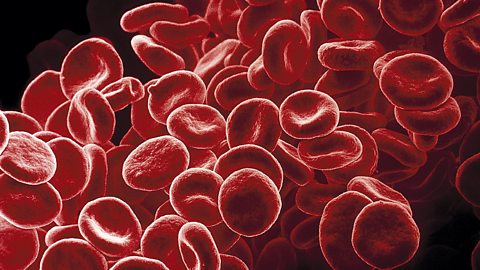Reproductive systems
Most animals carry out sexual reproduction.
Sexual reproduction involves the joining of two sex cells or gametes ÔÇô the sperm (male gamete) and the egg or ovum (female gamete).
The male and female reproductive system
The male reproductive system makes many sperm and can deliver it into the female reproductive system.
The female reproductive system makes and releases ova. It also protects and nourishes the foetus from fertilisation until birth.
The menstrual cycle
The menstrual cycle
The female reproductive system includes a cycle of events called the menstrual cycle. This starts after a female has reached puberty. Each menstrual cycle lasts about 28 days, but it can be slightly less or more than this. The cycle stops while a woman is pregnant. These are the main features of the menstrual cycle:
- The start of the cycle, day 1, is when bleeding from the vagina begins. This is caused by the loss of the lining of the uterus, with a little blood. This is called menstruation or having a period.
- By the end of about day 5, the loss of blood stops. The lining of the uterus begins to re-grow and an egg cell starts to mature in one of the ovaries.
- At about day 14, the mature egg cell is released from the ovary. This is called ovulation. The egg cell travels through the oviduct towards the uterus.
- If the egg cell does not meet with a sperm cell in the oviduct, the lining of the uterus begins to break down and the cycle repeats.
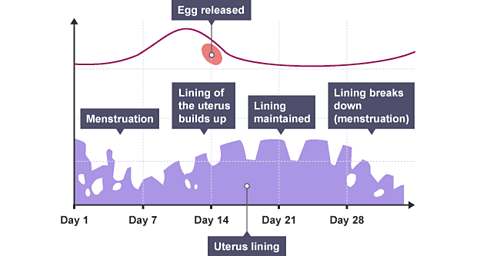
Fertilisation happens if the egg cell meets and joins with a sperm cell in the oviduct.
- the fertilised egg then imbeds to the lining of the uterus
- the woman has become pregnant, the lining of the uterus does not break down
- menstruation does not happen
Gametes and fertilisation
Humans typically reproduce through sexual reproduction. Sexual reproduction produces offspring that are unique individuals due to variants in their genes. This is because half of their genes come from each parent.
Gametes
Gametes are the sex cells and they have a half set of DNA:
- eggs are female gametes
- sperm are male gametes
Gametes have adaptations to increase the chances of fertilisation and successful development of an embryo.
Sperm cell adaptations include:
- A tail allowing it to swim through the female reproductive system and towards an egg cell.
- A haploid nucleus ÔÇô containing half the normal number of chromosomes.
- An acrosome (part of the tip of the head) that releases enzymes to digest the egg membrane when it comes into contact with an egg to allow the nuclei to fuse.
- Many mitochondria to produce energy required for the tail to swim.

Ovum or eggs are one of the biggest cells in the body and relatively, only a few are made.

Fertilisation and pregnancy
Fertilisation is the fusion of a sperm nucleus and an egg nucleus to form a zygote
A zygote is a fertilised egg and is the first stage of development. Fertilisation normally occurs in the oviduct, and a fertilised egg is smaller than this full-stop. Just nine months later it will be a fully developed fetus (also spelt ÔÇśfoetusÔÇÖ but pronounced the same) ready for birth and weighing approximately 3 kg.
After fertilisation:
The zygote travels down the oviduct, dividing to form a ball of cells (embryo).
When the embryo reaches the uterus, implantation occurs. This is when the embryo attaches to the thick uterus lining to receive nourishment.
The placenta, umbilical cord, amnion and amniotic fluid form.
The embryo develops, producing a variety of tissues and organs. It starts with a tail and lumps but these develop into legs and arms.
The embryo is referred to as a fetus when it begins to look more like a baby ÔÇô about nine weeks after fertilisation.
Fetal development and birth
The fetus relies upon its mother as it develops. These are some of the things it needs:
- protection against knocks, bumps and temperature changes
- oxygen for respiration
- nutrients (food and water)
- removal of it's waste substances
The fetus sits in the amnion which is a bag of liquid called amniotic fluid. This cushions and protects it from knocks, bumps and jolts as the mother moves. The uterus also protects the fetus.
The placenta
The placenta is an organ responsible for providing oxygen and nutrients, and removing waste substances. It grows into the wall of the uterus and is joined to the fetus by the umbilical cord.
The mother's blood does not mix with the blood of the fetus, but the placenta lets substances pass between the two blood supplies:
- oxygen and nutrients diffuse across the placenta from the mother to the fetus
- carbon dioxide and other waste substances diffuse across the placenta from the fetus to the mother

Birth
It takes about 40 weeks for a baby to develop in the uterus. This time is called gestation. After this, the baby is ready to be born.
During pregnancy the wall of the uterus has developed strong muscles ready for birth.
Birth begins with labour. The cervix relaxes and the muscles in the wall of the uterus contract. At some point during birth the amniotic sac bursts, releasing the amniotic fluid out of the vagina. This is referred to as the waters breaking and can happen before the contractions are felt or during active labour. Waves of muscle contraction help to push the baby out of the mother's body through the vagina. After this, the umbilical cord connecting the mother and baby is snipped with scissors.
Puberty
The reproductive system of a young child is not fully developed. It needs to change as a boy or girl develops into an adult, so that the system is fully working. The time when the changes happen is called puberty.
Most girls begin puberty between ages 8 and 14, with an average age of 11. Girls develop more quickly than boys and most finish puberty within four years. Most boys begin puberty between ages 9 and 14, with an average age of 12. Most boys finish puberty within six years.
The changes are triggered by sex hormones produced by the testes in boys and by the ovaries in girls. The time between puberty and adulthood during which these changes occur is called adolescence.There are some changes that are the same for boys and girls but there are many that are different for each sex.
Here are some changes that happen to both boys and girls:
- underarm hair grows
- pubic hair grows
- body smell gets stronger
- emotional changes
- growth rate increases
- acne may appear
- greasy hair
Girls
Here are some changes that happen only to girls:
- breasts develop
- ovaries start to release egg cells (the menstrual cycle starts)
- hips get wider
Boys
Here are some changes that happen only to boys:
- voice breaks (gets deeper)
- testes and penis get bigger
- testes start to produce sperm cells
- shoulders get wider
- hair grows on face and chest
Smoking and alcohol during pregnancy
Smoking and drinking alcohol and caffeinated drinks during pregnancy could risk the health of the unborn baby.
Smoking
- Woman increases her risk of miscarriage and stillbirth
- Babies have a greater risk of low birth weight
- Greater risk of premature birth
- Greater risk of sudden unexpected death in infants
Alcohol
Babies may have:
- facial abnormalities
- heart problems
- restricted growth
- mental disorders
- incorrect development of nervous system
Caffeine
Heavy use may be associated with increased risk of low birth weight
Drugs
Increased risk of:
- low birth weight
- birth defects
- premature birth
- growth retardation
- sleep problems
- behavioural problems
- miscarriage
- stillbirth
Contraception
Contraception includes any way, natural or physical, to intentionally prevent fertilisation following sexual intercourse.
There are mechanical, chemical, surgical and natural contraceptive methods used to prevent a pregnancy.
Mechanical
| Example | Method | Advantage | Disadvantage |
|---|---|---|---|
| Male condom | A barrier that prevents sperm entering the vagina. | Easily obtained. Protects against Sexually Transmitted Infections STIs (e.g. HIV). | Unreliable if not used properly. |
| Female condom | A barrier that prevents sperm reaching an egg. | Easily obtained. Protects against STIs (e.g. HIV). | Unreliable if not used properly. |
Chemical
| Example | Method | Advantage | Disadvantage |
|---|---|---|---|
| Contraceptive pill | Taken regularly by the female. Stops eggs being released | Very reliable | Female needs to remember to take the pill. Side effects include weight gain, mood swings or an increased risk of blood clots. Does not protect against STIs. |
| Contraceptive implant | A small tube placed under the skin of the upper arm. Releases hormones slowly over a long period of time. Stops eggs being released | Very reliable. Can work for up to 3 years. | Does not protect against STIs. Can prevent menstruation. |
Surgical
| Example | Method | Advantage | Disadvantage |
|---|---|---|---|
| Vasectomy | Sperm tubes are cut preventing sperm entering the penis. | Virtually 100% reliable. | Difficult or impossible to reverse. Does not protect against STIs |
| Female sterilisation | Oviducts are cut preventing fertilisation occurring. | Virtually 100% reliable. | Difficult or impossible to reverse. Does not protect against STIs |
Natural
| Example | Method | Advantage | Disadvantage |
|---|---|---|---|
| Rhythm method | Sexual intercourse is avoided around the time the egg is released. | No unnatural product is used | Very unreliable especially if the menstrual cycle is irregular. Does not protect against STIs |
The natural method is chosen by some groups opposed to contraception for religious or ethical reasons.
Infertility
Fertility is the natural ability of humans to reproduce.
Infertility is when a couple cannot get pregnant (conceive) despite having regular sex without contraception.
Estimates suggest that as many as 10 % of couples will face fertility problems and be either unable to have babies or need treatment to help them do so.
Treatments for infertility
IVF ÔÇô in vitro fertilisation
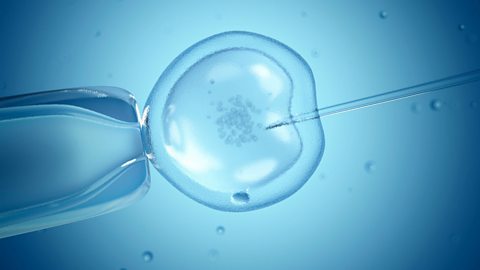
Process
- Female is given fertility drugs to increase egg production.
- Eggs are surgically collected from the ovaries.
- Sperm is collected from the male.
- Sperm and egg cells are mixed in the lab. 'In vitro' means 'in glass', ie a petri dish or cell culture dish - not a test tube!
- Female is given hormones to ensure the uterus lining is thick.
- Embryos are placed into the uterus.
- If successful an embryo/embryos will implant into the uterus lining ÔÇô the female is pregnant.

Usually only one or two embryos are placed into the uterus to give a balance between ensuring success and avoiding multiple births.Before placing the embryos into the uterus, it is possible to genetically screen them for abnormalities or check if they are a girl or a boy.
Other types of fertility treatment
| Treatment | Process |
|---|---|
| AIH (Artificial Insemination by Husband) | The sperm of the male is placed directly into the uterus of his female partner so that fertilisation can be achieved |
| AID (Artificial Insemination by Donor) | Similar to AIH, however, the sperm is provided by a donor who is not the woman's partner |
| Surrogacy | A woman carries and gives birth to a baby for another person or couple |
| Adoption | Legal responsibility is taken on for bringing up a child who was born to someone else |
HIV/AIDS

HIV stands for Human Immunodeficiency Virus. This infection is transmitted by body fluids, often during unprotected sex, but also through cuts and injecting drugs using shared needles. Immediately after infection, people often suffer mild flu-like symptoms. These pass, and for a period of time infected people might not know they are infected.

AIDS stands for Acquired Immune Deficiency Syndrome. Months or years after infection by the HIV virus, it becomes active and starts to attack the patientÔÇÖs immune system. At this point HIV has become AIDS.
There is no cure for HIV/AIDS, although many scientists are trying to find one. Currently, infected people are given antiviral drugs which can slow the development of AIDS and can allow those with HIV/AIDS to live a more normal life.
Each year it is estimated that 1.7 million people globally are newly infected with HIV. One way of trying to reduce new HIV infections is PrEP, a daily medication that is recommended to prevent getting HIV from sex or injection drug use.
PrEP is short for: Pre-exposure Prophylaxis.
Pre = before
Exposure = coming into contact with HIV
Prophylaxis = treatment to prevent an infection from happening
PrEP consists of a combination of two antiviral drugs, usually taken daily and often in combination with other HIV medicines. When taken consistently, it is estimated that PrEP reduces the risk of HIV infection by up to 92 percent
Structure of DNA

Genetic information is passed from one generation to the next. This is called heredity and is why we resemble our parents. The genetic information itself is contained in a complex molecule called DNA which stands for deoxyribonucleic acid.

Scientists worked out the structure of DNA in the 1950s. In 1951 Maurice Wilkins and Rosalind Franklin, both working at King's College, London, were using X-ray diffraction to study DNA. James Watson and Francis Crick working at the Cavendish Laboratories in Cambridge used FranklinÔÇÖs and WilkinsÔÇÖ findings to work out a model for the structure of DNA. They published the news of their discovery in 1953.
Watson, Crick and Wilkins shared the Nobel Prize for Medicine in 1962
Unfortunately, Rosalind Franklin had died in 1958 and, despite her key experimental work, the prize could not be received posthumously. Crick and Watson both received numerous other awards and prizes for their work.
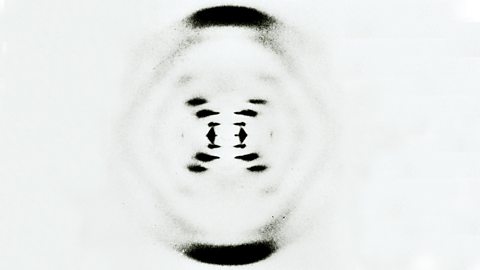
Watson and Crick were able to work out how DNA was arranged and the tiny distances between its different features. They worked out that in a DNA molecule:
- there are two strands
- the strands are twisted around each other to form a double helix
- the strands are held together by bonds between base pairs
The two sides of the DNA molecule are made up of alternating sugar and phosphate molecules which repeat themselves. This is the sugar phosphate backbone.
Attached to each sugar is a ÔÇśrungÔÇÖ or band which crosses between the strands. These are pairs of chemicals called bases.
Note that these are different to bases in relation to acids and alkalis in chemistry.
There are four different bases in DNA:
- thymine, T
- adenine, A
- guanine, G
- cytosine, C
The bases always pair up in a particular way:
adenine pairs with thymine (AÔÇôT)
guanine pairs with cytosine (GÔÇôC)
One way to remember this is:
After Tea, Gooey Cakes
The order of the bases along a strand of DNA is a code ÔÇô a code for making proteins. These proteins in turn will help to make up certain characteristics.
DNA is found inside the nucleus of every cell.
There is no DNA in mature red blood cells because they do not have a nucleus. They have no nucleus so they can contain more haemoglobin - the red protein that combines with oxygen.
Chromosomes, DNA and genes
The DNA in all of your cells is approximately two metres long, except red blood cells which have none and sperm or eggs which only have about one metre.
The DNA coils into structures called chromosomes. The chromosomes are found in the nucleus of each cell.
Human body cells each contain 23 pairs of chromosomes, 46 chromosomes in total.
Human sex cells or gametes (egg and sperm) only contain 23 chromosomes in total.
Each chromosome contains short sections of DNA called genes. These genes carry the instructions that determine features, such as eye colour, hair colour, blood group and height. Our largest chromosome contains about 8000 genes. Humans have between 20 000 and 25 000 genes. One copy of all your chromosomes is called your genome.
When an egg is fertilised by a sperm, it becomes a cell with a nucleus containing 23 pairs of chromosomes.
Each chromosome from the egg pairs up with a matching chromosome from the sperm. This brings genes together too. The genes for eye colour pair up, the genes for blood group pair up, the genes for skin colour pair up and so on.
This is why children resemble both their parents ÔÇô half of their chromosomes and DNA come from their mother, and half from their father.
Sex determination in humans
Of the 23 pairs of chromosomes in the nucleus of human body cells, one pair determines the sex of the individual.
This pair is called the sex chromosomes. The other 22 pairs match and are called autosomes
In males the sex chromosome pair is one X chromosome and one, smaller Y chromosome: XY
In females the sex chromosome pair is two X chromosomes: XX
All egg cells have one X chromosome.
50% of sperm cells have one X chromosome and 50% have one Y chromosome.
During fertilisation, there is a 50% chance that a sperm containing an X chromosome will fuse with the egg; this would result in a baby girl ÔÇô XX.
There is also a 50% chance that a sperm containing a Y chromosome will fuse with the egg; this would result in a baby boy ÔÇô XY.
Within a population there will be equal numbers of females and males.
(/bitesize/topics/zpffr82/articles/zvwbcj6 "What is DNA?")
Summary
| Structure or terms | Function |
|---|---|
| DNA | Deoxyribonucleic acid. The material inside the nucleus of cells carrying genetic information |
| Double helix | The shape of the DNA molecule with two strands twisted together in a spiral ÔÇô like a twisted ladder |
| Chromosome | Consists of a long strand of DNA. Human cells contain 23 pairs of chromosomes ÔÇô 46 chromosomes in total |
| Gene | A small part of a chromosome. They carry instructions that determine features like eye colour. Genes are the basic unit of genetics |
| Egg cell | Nucleus only contain 23 chromosomes in total |
| Sperm cell | Nucleus only contain 23 chromosomes in total |
| Female | Cells contain sex chromosome pair XX |
| Male | Cells contain sex chromosome pair XY |
| Egg cell | All egg cells have one X chromosome |
| Sperm cell | 50% of sperm cells have one X chromosome and 50% have one Y chromosome |
Genetic conditions
A mutation is a random change in the structure of a gene or in the number of chromosomes in a cell. Mutations can occur naturally before a cell divides. They can also be caused by environmental factors such as ultraviolet light, x-rays, gamma rays, smoking and some chemicals. A mutation changes the way an organism develops.
Mutation can disrupt the genetic information and therefore disrupt the normal gene activity within and can lead to cancer and other illnesses.
Some genetic conditions are inherited ÔÇô passed from parent to child. These conditions are also caused by mutations.
Examples include:
HaemophiliaSufferers are unable to clot their blood resulting in excessive bleeding, even from small cuts or bruises.
Cystic fibrosisMainly affects the lungs and digestive system, which become clogged with mucus leading to frequent infections. This causes problems with breathing and the digestion of food.
HuntingtonÔÇÖs diseaseAffects nerve cells in the brain, leading to brain damage.
Down syndromeIndividuals have reduced muscle tone and the development of knowledge, skills and problem solving maybe reduced
Genetic screening
Genetic screening involves testing people or groups of people for the presence of a particular genetic abnormality.One type of genetic screening is called amniocentesis.A long, thin needle is inserted through the abdomen wall, guided by an ultrasound image.The needle is passed into the amniotic fluid that surrounds the foetus and a small sample of the fluid is withdrawn.
Foetal cells in the fluid are then examined for the presence of genetic abnormalities such as Down syndrome and cystic fibrosis.As amniocentesis carries a 1% risk of miscarriage, it is usually only offered to pregnant women who are at a higher risk of having a child with a genetic abnormality.
Mothers with a greater risk include:
- Those who have previously carried a foetus with a genetic abnormality.
- Those who have a family history of a genetic condition.
- Older mothers.
- Those where possible problems have been identified in an earlier medical examination, for example a blood test.
When screening for Down syndrome, pregnant mothers are offered a blood test between 10ÔÇô14 weeks of pregnancy.
The blood test determines if having a Down syndrome child is more likely.
Amniocentesis is normally then offered to those mothers who appear to have a higher risk.
While not as accurate as amniocentesis, the blood test carries no risk to the foetus or the mother; it simply identifies those women who may wish to take the riskier amniocentesis procedure.
A genetic screening can:
- help to diagnose a rare health condition in a child
- guide doctors in deciding what medicine or treatment to give
GM crops
Genetic modification can be used to produce plants that improve food production. For example, a plant may be produced with improved resistance to pests.
However, there are ethical issues involved in genetic modification. There are concerns about the possible health risks of genetically modified food. For example, a GM food might contain a substance that causes an allergic reaction in some people, or higher levels of a poison naturally found in the food.
Others think it is morally wrong to create new life forms, or to move genes between different species.
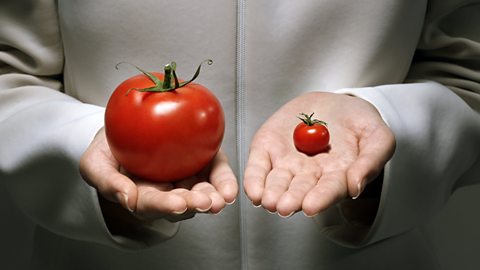
Cloning mammals
The cloning of animals has many important commercial implications. It allows an individual animal with desirable features, such as a cow that produces a lot of milk, to be replicated several times. Cloning of animals takes much longer than it does for plants.
Dolly the sheep
Dolly the sheep was the first mammal to be cloned. She was born in the UK in 1996 and died in 2003. She was produced using the nucleus from an udder cell from on sheep combined with an empty egg cell taken from a second sheep. The process is shown below.
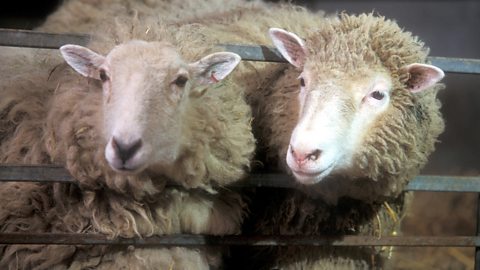
It was a breakthrough in the history of genetic engineering. Researchers hoped it would enable new ways of treating serious diseases, but critics were worried it opened the door to human cloning.
Stem cells
During the development of an embryo, most of the cells become specialised. Their structure develops to match their job, for example muscle cells and red blood cells. They cannot later change to become a different type of cell.
However, a stem cell is an unspecialised cell divides without limit and can grow into any type of cell found in the body.
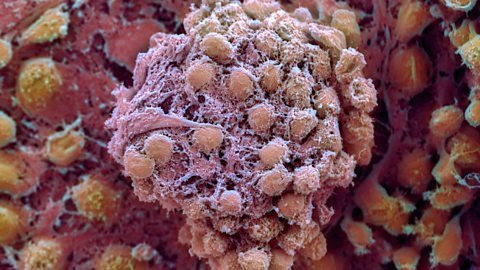
There are two types of stem cells:
- adult stem cells - these can develop into many (but not all) types of cell
- embryonic stem cells - these can develop into any type of cell

More on Biology
Find out more by working through a topic
- count6 of 11
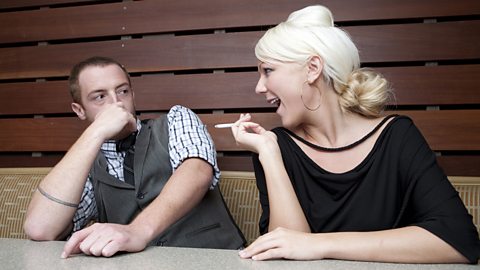
- count7 of 11
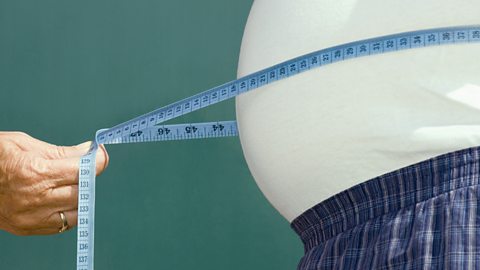
- count8 of 11

- count9 of 11
